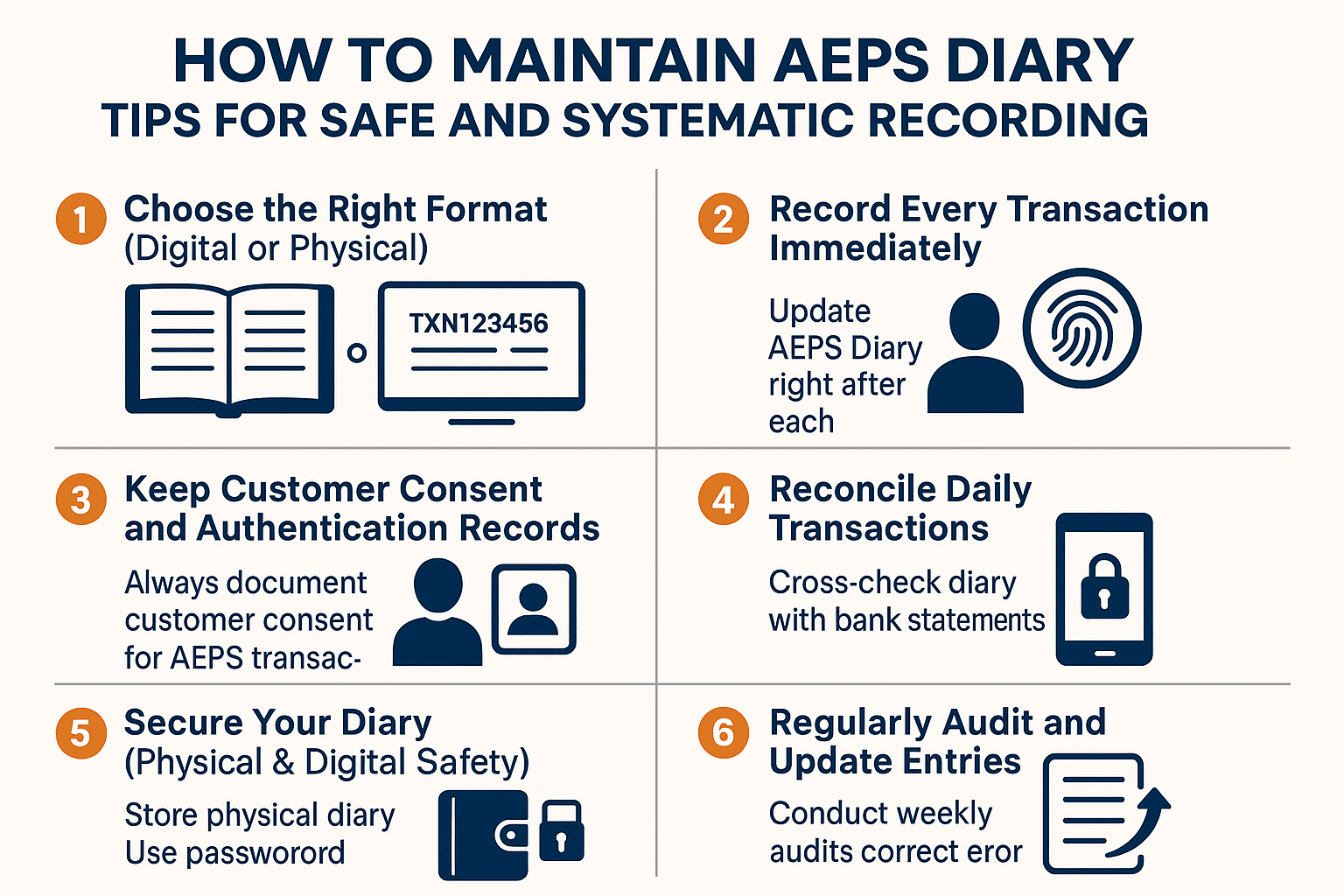Maintaining an AEPS diary is a crucial practice for banking correspondents, business correspondents (BCs), and agents who handle Aadhaar Enabled Payment System (AEPS) transactions. Proper record-keeping ensures transparency, minimizes errors, and safeguards against fraud.
In this guide, we’ll explore how to maintain an AEPS diary effectively, covering best practices, safety measures, and common mistakes to avoid. Whether you’re a new agent or an experienced BC, these tips will help you streamline your transactions and maintain compliance.
Why Maintaining an AEPS Diary is Important
The AEPS diary serves as a legal and financial record of all transactions conducted through the Aadhaar-linked payment system. Here’s why it’s essential:
-
Fraud Prevention: A well-maintained diary helps detect discrepancies and unauthorized transactions.
-
Regulatory Compliance: Banks and financial institutions require agents to keep transaction records for audits.
-
Dispute Resolution: If a customer claims a failed or incorrect transaction, the diary provides proof.
-
Financial Tracking: Helps agents reconcile daily transactions and manage cash flow efficiently.
According to a National Payments Corporation of India (NPCI) report, AEPS transactions crossed 1.2 billion in 2023, highlighting the need for systematic recording.

How to Maintain an AEPS Diary: Step-by-Step Guide
1. Choose the Right Format (Digital or Physical)
You can maintain an AEPS diary in two ways:
-
Physical Register: A handwritten ledger with columns for date, transaction ID, customer details, amount, and remarks.
-
Digital Tools: Mobile apps or Excel sheets that automate entries and reduce manual errors.
Example of a Physical AEPS Diary Format:
| Date | Transaction ID | Customer Name | Aadhaar Last 4 Digits | Amount (₹) | Transaction Type | Remarks |
|---|---|---|---|---|---|---|
| 10-03-24 | TXN123456 | Ramesh Kumar | 6789 | 2,000 | Cash Withdrawal | Success |
2. Record Every Transaction Immediately
-
Never delay entries—update the AEPS diary right after each transaction.
-
Verify details like Aadhaar last 4 digits and transaction ID to avoid mismatches.
3. Keep Customer Consent and Authentication Records
-
Always take customer signatures or biometric confirmations for high-value transactions.
-
If using a digital system, ensure SMS or app-based confirmations are saved.
4. Reconcile Daily Transactions
-
At the end of the day, cross-check your AEPS diary with your bank statement.
-
Report discrepancies immediately to your bank or AEPS service provider.
5. Secure Your Diary (Physical & Digital Safety)
-
Physical Diary: Store in a locked cabinet; avoid leaving it unattended.
-
Digital Records: Use password protection and regular backups.
6. Regularly Audit and Update Entries
-
Conduct weekly audits to ensure no missing or duplicate entries.
-
If errors are found, correct them with a note explaining the change.
Common Mistakes to Avoid in AEPS Diary Maintenance
-
Incomplete Entries – Missing transaction IDs or customer details create confusion.
-
Delayed Recording – Increases the risk of forgetting or misreporting transactions.
-
No Backup – Losing a physical diary or digital file can lead to financial losses.
-
Ignoring Small Transactions – Even minor amounts must be recorded for full transparency.
Advanced Tips for Efficient AEPS Diary Management
-
Use Automation Tools: Apps like AEPS Tracker or Excel macros can simplify recording.
-
Train Staff: If you have assistants, ensure they follow the same diary-keeping standards.
-
Stay Updated on RBI Guidelines: Compliance rules may change; always follow the latest protocols.

Frequently Asked Questions (FAQs)
1. Is maintaining an AEPS diary mandatory?
Yes, banks and regulatory authorities require agents to keep transaction records for audit and dispute resolution.
2. Can I use a mobile app instead of a physical diary?
Yes, digital tools are acceptable as long as they provide secure and accurate records.
3. How long should I keep AEPS transaction records?
Most banks recommend retaining records for at least 5 years for audit purposes.
4. What if a customer disputes a transaction?
Refer to your AEPS diary entry, check the transaction ID, and escalate the issue to your bank if needed.
5. How can I protect my AEPS diary from fraud?
-
Never share login details (for digital diaries).
-
Keep physical diaries under lock and key.
-
Regularly verify entries with bank statements.
Conclusion
Maintaining an AEPS diary is not just a regulatory requirement—it’s a best practice that ensures smooth, transparent, and secure transactions. By following the steps outlined above, you can minimize errors, prevent fraud, and build trust with your customers.
Whether you prefer a traditional ledger or a digital solution, consistency is key. Start implementing these tips today to enhance your AEPS diary management and streamline your banking operations.
Disclaimer
This post is for educational purposes only. If you have any concerns regarding the content, please refer to our DMCA page for removal requests. Always verify ownership or legal issues related to the information provided. For official guidelines, consult NPCI or your bank’s AEPS policy.
